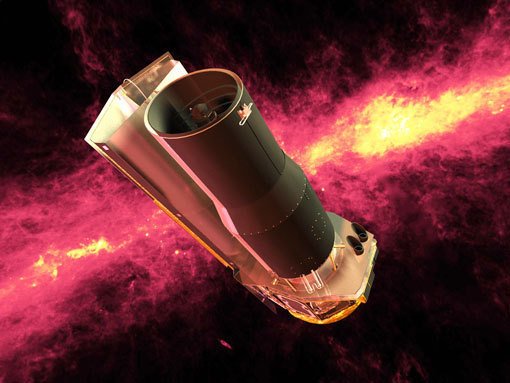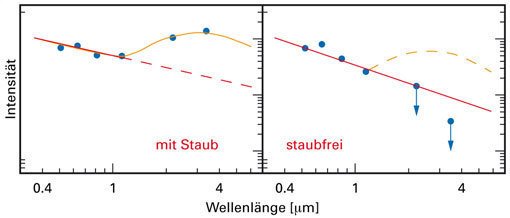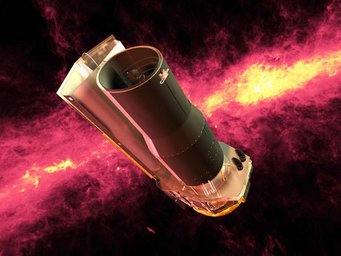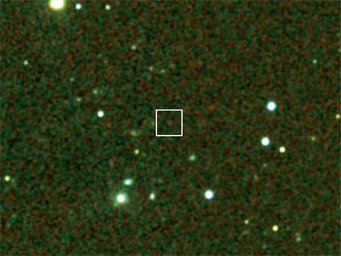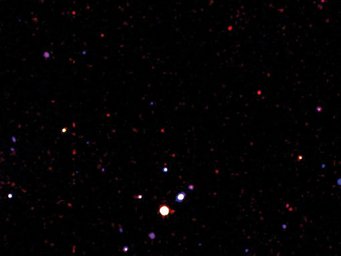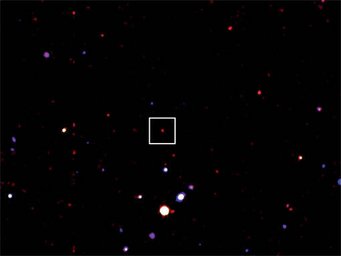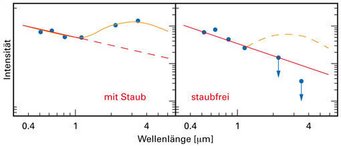Fire without smoke: Tracking down the most primitive black holes in the universe
Astronomers have found what appear to be the two most primitive black holes in the universe. Located at a distance of 12,7 billion light-years from Earth, we see these black holes or, more precisely, the bright galactic nuclei powered by these black holes, as they were 12,7 billion years ago, less than a billion years after the big bang. The existence of such primitive black holes had long been surmised, but until now, none had been observed. The results will be published in the March 18, 2010 issue of the journal Nature.
| Background information | Questions & Answers | Image download |
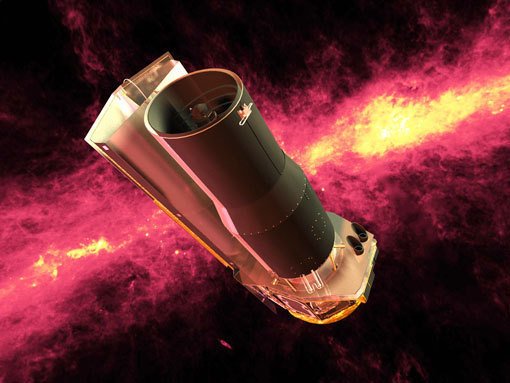
Quasars are the core regions of galaxies which contain active black holes. Such black holes are surrounded by brightly glowing “accretion disks”: disk of swirling matter that is spiraling towards the black hole. Such disks are among the brightest objects in the universe; in consequence, quasars are so bright that even at great distances, it is possible to investigate their physical properties in some detail.
It takes about 13 billion years for light from the most distant known quasars to reach us. In other words: We see these quasars as they were about 13 billion years ago, less than a billion years after the Big Bang. Looking that far into the past, one might expect to see half-formed, rather primitive precursors of more recent quasars. But in 2003, when the first of these very distant quasars were observed, researchers were greatly surprised to find that they were not markedly different in appearance from their modern kin.
Now a team of astronomers led by Linhua Jiang (University of Arizona, Tucson), which includes researchers from the Max Planck Institute for Astronomy in Heidelberg and the Max Planck Institute for Extraterrestrial Physics in Garching, has, for the first time, observed what appear to be very early, primitive quasars: quasars in an early stage of evolution, which are markedly different from quasars in the modern universe.
The astronomers used NASA’s Spitzer Space Telescope to observe infrared light from those extremely distant quasars. With infrared observations, one can identify the signature of hot dust, which is a standard feature of modern quasars – in such quasars, the central glowing disk (which is comparable in size to our whole Solar System) is surrounded by a gigantic dust torus (which is about a thousand times larger). In two of the 20 quasars observed, the dust signature proved to be conspicuously absent. This suggested that these two quasars might be very primitive: The very early universe contained no dust at all, so the first stars and galaxies should have been dust-free. They should be intensely hot and radiate brightly, but contain no dust particles: fire without smoke. The existence of such low-dust or even dust-free quasars had long been surmised, but such objects had not been observed – until now.
Thoroughly examining all available data, the astronomers found that none of the quasars that are closer to Earth – so that we see them at a later stage of their evolution – come even close to being this dust-free. Also, they found that, for the very distant quasars, there is a strong correlation between the mass of the quasar's central black hole and the amount of dust present. This indicates an evolutionary process, in which the central black hole grows rapidly by swallowing up surrounding matter, while, at the same time, more and more hot dust is produced over time.
All available evidence points towards the conclusion that finally, astronomers have managed to see quasar evolution in action, and that the two dust-free quasars indeed represent the most primitive black hole systems we know: quasars at an early stage of their evolution, too young to have formed a detectable amount of dust around them.
Background information
The results described here will be published as Jiang et al. “Dust-Free Quasars in the Early Universe” in the March 18, 2010 issue of Nature.
The team members are Linhua Jiang and Xiaohui Fan (University of Arizona, Tucson), W. N. Brandt (Pennsylvania State University), Chris L. Carilli (National Radio Astronomy Observatory, Socorro, New Mexico), Eiichi Egamii (University of Arizona, Tucson), Dean C. Hines (Space Science Institute, Boulder, Colorado), Jaron D. Kurk (Max Planck Institute for Extraterrestrial Physics, formerly Max Planck Institute for Astronomy), Gordon T. Richards (Drexel University, Philadelphia), Yue Shen (Harvard-Smithsonian Center for Astrophysics, Cambridge, MA), Michael A. Strauss (Princeton University, Princeton), Marianne Vestergaard (University of Arizona and Niels Bohr Institute, Copenhagen), and Fabian Walter (Max Planck Institute for Astronomy).
Parts of Xiaohui Fan's work were done when he was a long-term guest at the Max Planck Institute for Astronomy.
Questions and Answers
Which particular low-dust quasars were observed?
The quasars are known only by a numbering scheme that incorporates information about their positions. One of the quasars is SDSS J0005-0006 (where SDSS denotes the Sloan Digital Sky Survey, which first discovered this quasar), the other is SDSS J030-0019.
How far away are these quasars?
At cosmological scales, there are several possible definition of distance. In this release text, we use light travel time, the time it takes light from a distant object to reach us; by this measure, the two distant galaxies are 12,7 billion light-years away. In cosmology, an object’s redshift – how far its light is shifted towards longer wavelengths – is directly related to distance; usually (as in this case), distance is deduced from the redshift, which is readily measurable. These quasars have redshift values of z = 5.85 and z = 6.05, respectively. For the second quasar, this means that as its light reaches Earth, its wavelengths are seven times (z + 1 = 7.05) as long as when the light was emitted by the quasar.
How are distance and age related?
Astronomers always observe the past: Light travels at a constant, finite speed. The Sun’s light takes 8 minutes to reach Earth, so we always see the Sun as it was 8 minutes ago – light that carries information about more recent events on the Sun has not reached us yet. A nearby galaxy’s light might take millions of years to reach us, and we see that galaxy as it was millions of years ago. When it comes to very distant galaxies, astronomers look billions of years into the past.
Which kinds of measurement were made?
At such great distances, it is impossible to make out the different parts of a distant galaxy, but one can derive information about these objects from their spectra, that is, from measurements of how much light an object emits at different wavelengths. Hot dust emits light at infrared wavelengths. Astronomers can model the way in which the quasar's different regions, such as the accretion disk, dust and gas, contribute to the object's total infrared emission. For ordinary quasars, there is very good agreement between the prediction of these models and observations; for the two dust-free quasars, there is good agreement between the observations and models in which there is no dust at all.
Spectra are a key tool of astronomy: As every rainbow demonstrates, white light can be split up into different colors. Astronomers artificially split up the light they receive from distant objects into its different colors (or “wavelengths”). However, where we distinguish five or six rainbow colors, astronomers map hundreds of finely nuanced colors, producing a spectrum – a record of the different amounts of light the object emits in each narrow color band. Also, where we see only a rainbow's visible light, astronomers probe other region of the electromagnetic spectrum. The spectra used here were obtained in the infrared region. The spectrum's properties – more light emitted at some colors, less light at others – provide tell-tale signs about the chemical composition and other properties of the matter producing the light, such as the presence of dust.
How did the astronomers test their hypothesis that these are the first black holes?
If these two quasars indeed represent a very early, dust-free stage of quasar evolution, then quasars like this should only be found when looking into the distant past, that is, at very distant objects. To make sure, the researchers examined the 20 very distant quasars and all the 362 much closer quasars for which the same kinds of observational results have been published. The comparison shows that the two dust-free quasars are indeed markedly different from all the other quasars, and in particular from all the much closer quasars. By this measure, it is very likely that their special properties are indeed related to the fact that we are looking almost 13 billion years back in time.
Nothing that has entered a black hole can escape, and so black holes grow steadily in mass. In the very distant quasars but, significantly, not in their more modern counterparts, black hole mass is strongly related to the amount of hot dust present: more mass, more dust. This indicates a co-evolution: We are looking at quasars with central black holes that are initially very small, but grow very rapidly in mass as they swallow more and more matter. At the same time, more and more dust is produced. There are two likely production mechanisms: in outflowing winds, streams of highly ionized atoms that are blown outwards from the quasar's central region and that provide conditions suitable for the formation of dust, or in star-forming regions very close to the central black hole, where dust is produced by young stars.
How are the masses of the quasar's central black holes measured?
From studies on galaxies that are closer to Earth than these distant quasars, astronomers have been able to derive a relation between the speed of rotation of the swirling accretion disk surrounding a supermassive black hole and the black hole's mass. For the distant quasars, certain features of the spectrum indicate the accretion disk's rate of rotation (using the so-called Doppler effect); from these measurements, the black hole mass is deduced.
What telescopes were used to obtain these results?
The results presented here were obtained with the Spitzer Space Telescope, one of NASA's Great Observatories, which was launched in 2003. The distant quasars were observed in 2006-2009, with the final in-depth observations completed shortly before May 2009, when Spitzer ran out of liquid helium, the coolant needed for high-sensitivity infrared measurements.


Download area
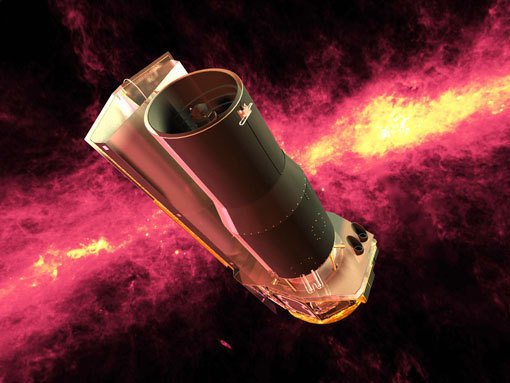

- JPG RGB 510 x 383 pxl 47.32 kB
- JPG RGB 1200 x 900 pxl 149.82 kB
- TIF CMYK 2400 x 1800 pxl 7.84 MB
- JPG RGB 510 x 510 pxl 52.53 kB

- PDF CMYK 84.52 kB
- JPG RGB 510 x 383 pxl 48.97 kB
- JPG RGB 1200 x 900 pxl 153.98 kB
- JPG RGB 510 x 510 pxl 54.34 kB

- JPG RGB 510 x 383 pxl 17.68 kB
- JPG RGB 1200 x 900 pxl 55.21 kB
- TIF CMYK 2400 x 1800 pxl 5.62 MB
- JPG RGB 510 x 510 pxl 22.48 kB

- PDF CMYK 33.74 kB
- JPG RGB 510 x 383 pxl 14.31 kB
- JPG RGB 1200 x 900 pxl 36.34 kB
- JPG RGB 510 x 510 pxl 15.54 kB

